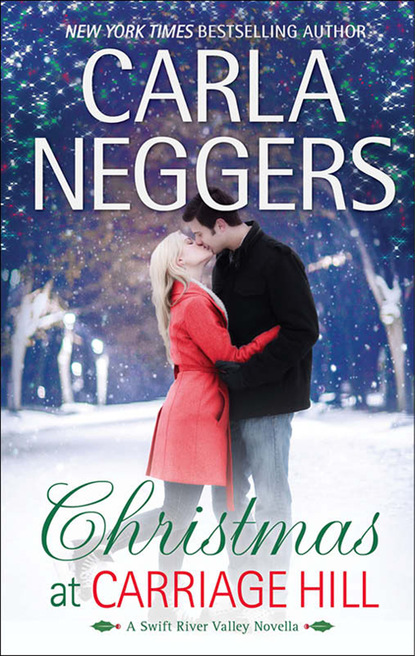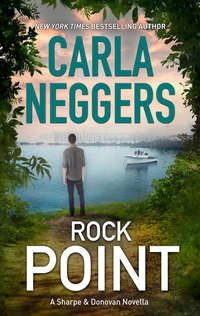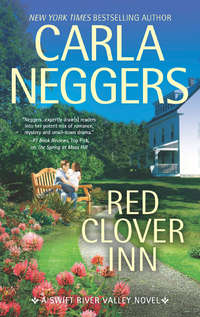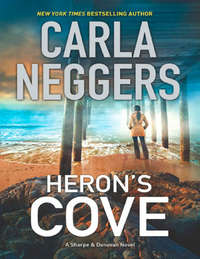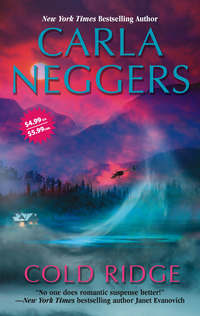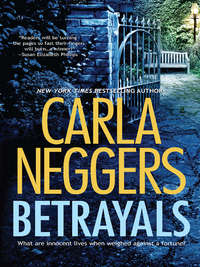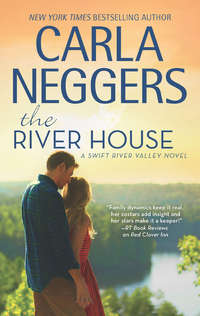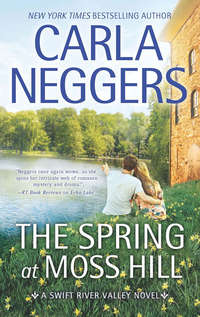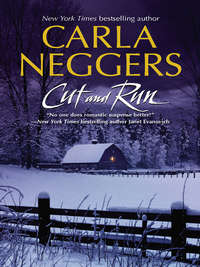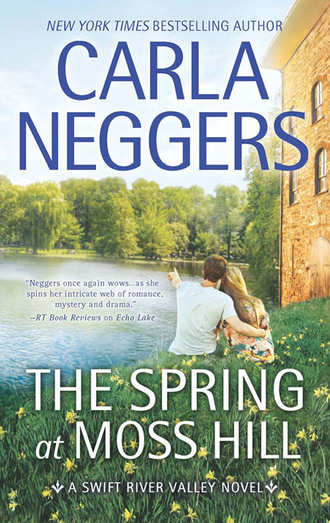
Полная версия
The Spring At Moss Hill

New York Times bestselling author Carla Neggers returns to charming Swift River Valley, where spring is the time for fresh starts and new beginnings...
Kylie Shaw has found a home and a quiet place to work as an illustrator of children’s books in little Knights Bridge, Massachusetts. No one seems to know her here—and she likes it that way. She carefully guards her privacy in the refurbished nineteenth-century hat factory where she has a loft. And then California private investigator Russ Colton moves in.
Russ is in Knights Bridge to keep his client and friend, eccentric Hollywood costume designer Daphne Stewart, out of trouble. Keeping tabs on Daphne while she considers starting a small children’s theater in town doesn’t seem like a tough job until he runs into Kylie. Her opposition to converting part of the old hat factory into a theater is a challenge. But his bigger challenge is getting Kylie to let loose a little...like the adventurous characters she depicts in her work.
Kylie and Russ have more in common than they or anyone else would ever expect. They’re both looking for a place to belong, and if they’re able to let go of past mistakes and learn to trust again, they might just find what they need in Knights Bridge...and each other.
Praise for Carla Neggers’ New York Times bestselling Swift River Valley novels
“Appealing protagonists, good neighbors, small-town Christmas traditions, and Neggers’s own recipes make for a fine romance.”
—Publishers Weekly on A Knights Bridge Christmas
“A heady mix of romance, mystery and genuine Quabbin history packaged in an enchanting holiday tale.”
—RT Book Reviews on A Knights Bridge Christmas
“Neggers does the near impossible: she brings a small-town, family-loving heroine and a footloose hero together in an engaging romance that has its fair share of surprises.”
—Library Journal on Echo Lake
“Her people, places and things are colorfully and expertly rendered in this compelling work of fiction.”
—RT Book Reviews on Cider Brook
“Neggers captures readers’ attention with her usual flair and brilliance and gives us a romance, a mystery and a lesson in history.”
—RT Book Reviews, Top Pick, on
Secrets of the Lost Summer
“Only a writer as gifted as Carla Neggers could use so few words to convey so much action and emotional depth.”
—Sandra Brown
“[Neggers] forces her characters to confront issues of humanity, integrity and the multifaceted aspects of love without slowing the ever-quickening pace.”
—Publishers Weekly
The Spring at Moss Hill
Carla Neggers

www.millsandboon.co.uk
For my mother,
who taught me and so many others how to sew
Contents
Cover
Back Cover Text
Praise
Title Page
Dedication
One
Two
Three
Four
Five
Six
Seven
Eight
Nine
Ten
Eleven
Twelve
Thirteen
Fourteen
Fifteen
Sixteen
Seventeen
Eighteen
Nineteen
Twenty
Twenty-One
Twenty-Two
Twenty-Three
Twenty-Four
Twenty-Five
Twenty-Six
Twenty-Seven
Twenty-Eight
Author’s Note
Extract
Copyright
One
“What do you think a private investigator would want me to stock in his fridge and pantry?”
The provocative question came from Ruby O’Dunn, up front by the cash register at the Swift River Country Store, a fixture in Knights Bridge, Massachusetts, for at least a century. Ruby was speaking to Christopher Sloan, a local firefighter. Kylie Shaw, out of sight in the wine section, had spotted them coming into the store. Now she wished she’d been paying closer attention to their conversation. Private investigator? What private investigator?
“He’s from Beverly Hills,” Chris said. “I’d start with that.”
“He works for a Beverly Hills law firm. I don’t know if he’s actually from Beverly Hills.”
“Close enough.”
“It’d almost be easier if we were having him stay with my mother. She’s got a fully stocked kitchen.”
“She also has goats.”
“Don’t get me started. I cleaned out their stalls this morning. It’s bedlam at her place. Even staying there a few days would be a lot to ask. Moss Hill is a much better choice.”
Kylie held tight to a bottle of expensive champagne.
Moss Hill?
Moss Hill was a former nineteenth-century hat factory that had undergone extensive renovations and opened in March, with offices, meeting space and residences. She’d moved into one of its four loft-style apartments five weeks ago. So far, she was the only tenant. She accepted that the other three apartments wouldn’t stay empty, but she hadn’t ever—not once—imagined a private investigator moving in, even temporarily.
She missed what Chris said in response to Ruby. Ruby went on about wild mushrooms, artisan cheese and artichokes, but Chris finally told her to focus on basics. “Put a six-pack in the fridge,” he said. “It’ll be fine.”
Ruby muttered something Kylie couldn’t make out, and Chris left, apparently with a six-pack of his own.
Kylie placed the champagne in her basket. She’d promised herself she would take time to celebrate once the daffodils were in bloom, and they were definitely in bloom. The last time she’d come up for air and tried to celebrate had been in August. She’d ended up at a Red Sox game with a negative, burned-out carpenter who complained for seven innings. She’d been relieved when the game didn’t go into extra innings and had told him she’d had a call from her sister, a veterinary student at Tufts, to get out of going back to Knights Bridge with him. Before that, she’d split a bottle of wine with a condescending sculptor in Paris, celebrating her first children’s book as both author and illustrator. These little children’s drawings you do are sweet, Kylie, but... He’d shrugged, leaving her to imagine the rest of what he was pretending to be too polite to say. She couldn’t make a living as an illustrator, they weren’t real art, they weren’t any good, anyone could do it. It had been that kind of but.
She headed to the cash register with her basket. She could always have her champagne alone on her balcony and toast the stars and the moon, with gratitude.
Maybe invite the Beverly Hills PI.
That’d be the day. She didn’t plan to do anything to invite his scrutiny.
Ruby was lifting a basket off a stack by the register. Kylie had met all four O’Dunn sisters around town—the country store, the library, the town offices where their mother worked—but didn’t know any of them well. She’d moved to Knights Bridge last summer and kept telling herself she wanted to get to know people there, but so far, they remained acquaintances, not friends. Ruby and Ava, fraternal twins and the youngest O’Dunns, were theater graduate students, Ava in New York, Ruby in Boston. A natural redhead like her three sisters, Ruby had dyed her hair plum-black and tied it back with a bright pink scarf. She wore a long black skirt, a white T-shirt and a denim jacket, with black boots and no jewelry.
“Oh, Kylie, hi,” Ruby said. “I didn’t see you back there.”
“I couldn’t resist the wine sale.”
“Ah. Champagne, I see. Excellent. Did you hear Chris Sloan and me talking just now? A private investigator will be here from California tomorrow. He’ll be staying in the apartment across the hall from you.”
“What’s he investigating?”
“One of his clients is giving a master class at Moss Hill next Saturday,” Ruby said. “Daphne Stewart—she has roots in town.”
“She was here last September for the vintage fashion show at the library,” Kylie said. “Hollywood costume designer. I remember.”
“Did you go?”
“No, I didn’t.” She’d been fiddling with a project ahead of hitting the Send button. Work was always her excuse for not being more social. “I heard it was a great success.”
“The fashion show raised a lot of money for the library and the historical society.” Ruby hooked her basket on one arm. “Daphne’s a character. Russ Colton—the private investigator arriving tomorrow—is making sure everything’s set for her arrival. It’ll be Moss Hill’s first public event. You should come, Kylie. You’ll be right there.”
“Thanks. I’ll give it some thought.”
Ruby held up her basket. “I need to fill this up. I should get moving. Good to see you.”
“You, too,” Kylie said, but Ruby had spotted someone she knew and taken off down the canned-goods aisle.
Kylie set her basket on the counter.
A private investigator and a respected, longtime Hollywood costume designer on their way to town—to Moss Hill.
Just what I need.
She held back a groan. If she couldn’t fake excitement, best to be neutral.
She unloaded her groceries. In addition to the champagne, she’d picked up plain yogurt, cheddar cheese, flax-seed bread, coffee and mixed spring greens, all local to her quiet part of New England, west of Boston.
After paying for her groceries, she stepped outside. The beautiful April afternoon greeted her like a warm smile from a friend. She took in the quaint, picturesque village center. She was standing on Main Street, opposite the common, an oval-shaped green surrounded by classic houses, the library, churches, the town hall and a handful of small businesses. The long winter had released its grip. The grass was green, the trees were leafing out, and daffodils were in bloom. She had been working nonstop for weeks—months—and getting out into the warm spring air felt remarkably good, almost as if she’d come to life herself.
She noticed dark-haired, broad-shouldered Christopher Sloan farther down Main Street. He was the fifth of the six Sloan siblings, with four older brothers. She couldn’t imagine having five brothers. She didn’t have any brothers. The O’Dunns and the Sloans and other families had lived in Knights Bridge for decades, even for generations. Ruby and Chris had grown up together. That created bonds and a familiarity that Kylie couldn’t pretend to have in her adopted town.
Or want.
Not now at least.
She arranged her groceries in her bike bags, aware of a vague uneasiness about the arrival of a private investigator at Moss Hill. It wasn’t just that she wasn’t thrilled about it. She’d worked hard not to draw attention to herself during her months in Knights Bridge.
But it would all work out, she told herself as she climbed on to her bike. She had champagne, food and coffee. If she so much as sensed this Russ Colton was going to cause trouble for her, she could hide out in her apartment for days, content in her world of evil villains, handsome princes and daring princesses.
* * *
Moss Hill was quiet even for a Saturday afternoon. Kylie’s mud-spattered Mini was the only vehicle in the parking lot, so new it didn’t have a single pit or pothole. She could feel the ten-mile round-trip ride in her thighs as she jumped off her bike. She’d relished the slight breeze and the fresh scents of spring in the air on this warmest day of the year so far.
She grabbed her groceries out of her bike bags and gave them a quick check. Somehow she’d managed not to break or spill anything. She started to slip her phone into her jacket pocket but saw she had a voice mail.
Her sister, Lila, three years younger, still hard at work as a veterinary student in Boston. Also still a chronic worrier who was convinced her only sibling was turning into a recluse.
Kylie listened to the message, smiling at its predictability. “I hope you’re not answering because you’re off having a great time with friends. Call back whenever. Just saying hi.”
Lila had known at four that she wanted to be a veterinarian like their father. She’d never wavered. Kylie had always been more interested in drawing pictures of the animals that came in and out of the Shaw clinic than in operating on them.
She hadn’t been out with friends. She’d missed her sister’s call because she’d turned off her phone while she was on her bike.
She’d call Lila back later.
Kylie left her bike on the rack by the front entrance and followed a breezeway to the residential building, the smaller of the two brick-faced structures that formed the mill, or at least what remained of its original complex. Built in 1860 to capitalize on the burgeoning market for palm-leaf straw hats, the renovated mill was situated on a small river on the outskirts of town. Its namesake rose up across the road.
Moss Hill was one of the many knobs and hills that formed the uplands that had helped make the region attractive as a source of drinking water for metropolitan Boston. The bowl-shaped Swift River Valley had caught the eye of engineers and politicians, and the massive Quabbin Reservoir was created in the decades prior to World War II. Four small towns were disincorporated, their populations relocated, their homes and businesses razed, their graves and monuments moved, and Windsor Dam and Goodnough Dike were built, blocking the flow of three branches of the Swift River and Beaver Brook and, through the 1940s, allowing the valley to flood.
Even before Quabbin, the mill had been in decline, little realistic hope for its future. Straw hats had been going out of fashion, and by 1930, the mill stopped producing them. Subsequent owners hadn’t succeeded with alternative businesses. Eventually, the old buildings were boarded up and abandoned. A few years ago, a local architect and his business partners had bought the property and begun the painstaking process of demolition, renovation and refurbishment.
Kylie took the industrial-style stairs to the second floor. In addition to its four apartments, the building included a well-equipped exercise room, lounge and lower-level parking and storage. Although she’d grown up in the western exurbs of Boston, she’d never heard of Knights Bridge until a friend, an art professor recently hired by the University of Iowa, had told her about her country house. You need a place to work for a few months, and I need a renter until I figure out what to do.
Kylie had only meant to stay in Knights Bridge three months—long enough to catch up on work and clear her head. But three months had turned into six, then eight, and when her friend decided to sell the house because Iowa was just too far away, she had taken a look at Moss Hill.
She’d been captivated by the transformation of the old mill and had surprised herself when she fell in love with her second-floor loft-style apartment. She’d loved the house she’d been renting, too. Charming, quiet and romantic, it had cried out for kids, dogs, chickens—a family.
She unlocked her door and went inside, relaxing now that she was back in her space. She set her groceries on the counter in the kitchen area. She was only a little more than a month into living here, but the open layout suited her. Tall ceilings, arched floor-to-ceiling windows overlooking the river, brick and white-painted walls and gleaming wood floors combined old and new, the specialty, she’d come to learn, of the owner and architect, Mark Flanagan. He’d thought of everything to make the space comfortable, contemporary and efficient. His wife, who worked at a local sawmill owned by her family, had helped with the finishing touches.
Since her previous rental had come furnished, Kylie had been scrambling to get things pulled together for this place. A buttery-leather sectional had been delivered a week ago, and she’d finally given up a ratty futon she’d dragged out of her parents’ basement and bought a decent bed, queen-size with washed-linen sheets. She hated scratchy sheets.
She’d brought her worktable with her. She’d made it herself in college out of a finished birch-wood door on trestles, and it had gone with her almost everywhere since then. Not Paris or London; she’d left it in storage then.
She put the champagne in the refrigerator. She needed something concrete to celebrate before she opened it. It didn’t have to be big, but it had to be more than daffodils being in bloom. That felt forced.
Because it is forced, she thought.
She put away the rest of her groceries and flopped on the couch, tugging the clip out of her hair, which, despite being pulled back, was tangled from her bike ride. It was pale blond and past her shoulders, and she kept promising herself she would get to a hair salon. She was okay with a pair of scissors and could manage a quick trim, but she wasn’t a pro.
Too restless to sit for long, she got to her feet, yanking off the lightweight jacket she’d worn into town. She kicked off her shoes and walked in her stocking feet to her worktable. She’d been working on Little Red Riding Hood for only a few days. It was the third in a series of fairy tales she was illustrating. She’d finished Hansel and Gretel and Sleeping Beauty.
She knew it would take some effort to get her into the world of a clever wolf, a dark forest and an adventurous girl with a picnic basket.
Kylie sank onto her chair, feeling unsettled, strangely out of her element. Had she made a mistake moving here?
But she knew she hadn’t. As fantastic as it was, the house she’d rented had made her think about what she didn’t have. This place worked fine, given her solitary ways and her bad luck with men.
* * *
She lasted twenty minutes at her worktable.
She was working on the perfect tree to go in front of the grandmother’s house in Little Red Riding Hood. She was doing sketches by hand, on paper. She stared at the last one. Not good. It looked more appropriate for a story about zombies than a classic fairy tale.
She balled it up and tossed it into the recycling bin under her table, on top of the other discarded sketches. She debated switching to her computer and drawing on her art board, but she knew from experience that wouldn’t work, either.
Her tree needed more time. It wasn’t there, and working harder and longer wasn’t going to make it be there.
Also, she was distracted.
She noticed Sherlock Badger tucked at the base of her task lamp and smiled. She’d put him together with bits of fabric, dryer lint, a few notions she raided from discarded clothes, a needle and thread and glue.
Now here was a guy, Kylie thought.
Never mind that he was only four inches tall.
He was a law enforcement officer in a series of picture books for young readers she’d created. He wasn’t in all the books. He didn’t live in Middle Branch, the fictional town where his Badger cousins had a house and a veterinary clinic on a river.
Kylie pointed her finger at him. “Not a word about my Little Red Riding Hood tree. Not. A. Word.” She tossed her sketching pencils in their basket, one she’d picked up in Paris, before that ill-fated bottle of wine with the sculptor. “I’m not stuck. I’m just thinking.”
She picked a piece of lint off Sherlock. He had a square jaw and a tough look about him, but he was solid, trustworthy and brave.
What would Sherlock do if a private investigator came to Middle Branch?
It would depend on what people had to hide, wouldn’t it?
Kylie felt her throat tighten. She sprang to her feet, restless, uncertain. Three years ago, when she’d had the idea for The Badgers of Middle Branch, the first book she would write as well as illustrate, she’d decided to work under a pseudonym and keep Kylie Shaw separate.
She’d chosen Morwenna Mills as her alter ego.
A year later, when the Badgers had debuted, they had been an instant hit with young readers. More Badger books followed. Instead of telling everyone she was Morwenna, Kylie had kept it to herself. Even her family didn’t know. Lila didn’t know.
Would Russ Colton, PI, want to know?
He didn’t have to want to know. All he had to do was start asking questions about the only resident at Moss Hill, and he could complicate her life.
Two
Russ Colton had considered all the ways he could get out of this trip to Knights Bridge, Massachusetts, but he was stuck. He had to go. Right now, he was on the deck of the hillside Hollywood Hills home owned by his friend Julius Hartley, also an investigator with Sawyer & Sawyer. Russ was trying to savor the last of his coffee, but he had Daphne Stewart eyeing him from across the hexagon-shaped table.
Finally she sniffed and sat up straight. “I know what you’re thinking.”
Russ looked at Julius for help. When Julius had heard Daphne coming up the stairs from the street, he’d suddenly developed a driving need to pick dead leaves off his multiple potted plants. He didn’t meet Russ’s eye now. Thrown to the wolves, Russ thought. More accurately, wolf, in the form of petite, copper-haired Daphne Stewart, a diva in her early sixties.
“What am I thinking, Daphne?” Russ asked her.
“This trip is a waste of time.”
“It is a waste of time. You don’t have to read my mind. I told you.”
“You gave me your professional opinion. I get that, but I have a bad vibe about my return to Knights Bridge. I’ve learned to trust my vibes. They’re not always right, I admit that, but they’re not always wrong, either.” She sniffed. “I’m willing to pay for my peace of mind.”
She settled back in her chair, eyeing Russ as if daring him to argue with her. She wore a close-fitting top with a deep V-neck and slim pants, both in the same shade as her dark green eyes. Even early on a Saturday afternoon, she had on gold earrings, a bunch of rings and gobs of makeup. But she pulled it off. She looked good. She always did. As a costume designer, she’d told Russ, she felt she should make an effort with her attire whether she was running out for a quart of milk or attending the Academy Awards.
Julius piled more plant debris onto the deck rail. He was in his fifties—twenty years older than Russ—and newly married to a San Diego attorney. He had on expensive golf clothes, his usual attire these days. He had two grown daughters by his first marriage, both Los Angeles attorneys. The younger one was buying his house, now that he was moving into his wife’s La Jolla home. Russ figured he could afford a Harry Potter cupboard in either La Jolla or Hollywood Hills.
“Why is this place called Moss Hill?” Julius asked Daphne.
She shuddered. “I hate that I know the answer. It’s at the base of an actual hill of that name.”
“Is there moss?”
“I don’t know. Honestly, Julius.”
He tackled a fernlike plant, grabbing a handful of brown matter. “Was it always called Moss Hill?”
“Yes. Sort of. It was called Moss Hill to distinguish it from the other Sanderson mills in the area. They’re all gone now, most of them demolished when the reservoir was built.”
Russ tried to control his impatience. He didn’t care what the damn place was called. It was in this nowhere-town, and he had to get on a plane tonight, fly to Boston and drive there in the morning.
“My great-great-grandfather, George Sanderson, built the mill in the nineteenth century,” Daphne said. “It produced straw hats until sometime after World War I.”
“Like the straw hat Dick Van Dyke wears in Mary Poppins?” Russ asked.
Julius and Daphne both raised their eyebrows. Julius held his clippers in midair. “You’ve watched Mary Poppins? Seriously?”




